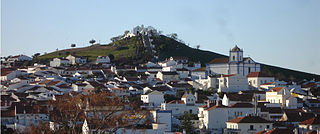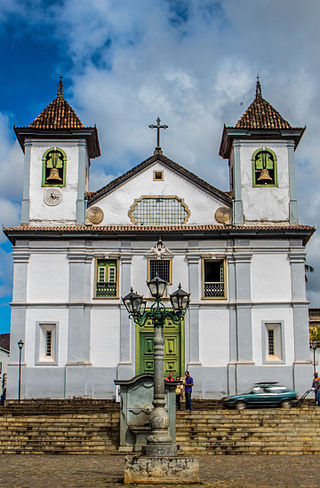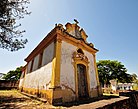
Ouro Preto, formerly Vila Rica, is a Brazilian municipality located in the state of Minas Gerais. The city, a former colonial mining town located in the Serra do Espinhaço mountains, was designated a World Heritage Site by UNESCO due to its Baroque colonial architecture. Ouro Preto used to be the capital of Minas Gerais from 1720 until the foundation of Belo Horizonte in 1897.

Praia da Vitória is a municipality in the Portuguese archipelago of the Azores. With a population of 21,035, the second largest administrative authority on the island of Terceira, it covers an area of 162.29 square kilometres (62.66 sq mi), that extends from the northern coast halfway into the interior.

São João del-Rei is a Brazilian municipality in the state of Minas Gerais. Founded in 1713 in homage to king John V of Portugal, the city is famed for its historic Portuguese colonial architecture. The current population is estimated at 90,225 inhabitants.

Aljustrel is a town and a municipality in the Portuguese district of Beja. The population in 2011 was 9,257, in an area of 458.47 km2. The present mayor is Nelson Domingos Brito, elected by the Socialist Party. The municipal holiday is June 13.

São Cristóvão is a Brazilian municipality in the Northeastern state of Sergipe. Founded at the mouth of the Vaza-Barris River on January 1, 1590, the municipality is the fourth oldest settlement in Brazil. São Cristóvão is noted for its historic city square, São Francisco Square, and numerous early colonial-period buildings. The 3 hectares site was designated a UNESCO World Heritage Site in 2010.

Cachoeira is an inland municipality of Bahia, Brazil, on the Paraguaçu River. The town exports sugar, cotton, and tobacco and is a thriving commercial and industrial centre.

Colares is a civil parish along the coast of the municipality of Sintra. The population in 2011 was 7,628, in an area of 33.37 square kilometres (12.88 sq mi).

The Roman Catholic Archdiocese of Mariana is an archdiocese based in the city of Mariana in the Brazilian state of Minas Gerais.

Manoel da Costa Ataíde, better known as Mestre Ataíde, was a Brazilian painter, sculptor, gilder and teacher.

São Francisco do Conde is a municipality in the state of Bahia in the North-East region of Brazil. São Francisco do Conde covers 262.856 km2 (101.489 sq mi), and has a population of 40,245 with a population density of 150 inhabitants per square kilometer. It is located 67 kilometres (42 mi) from the state capital of Salvador. According to the Brazilian Institute of Geography and Statistics São Francisco do Conde has the highest concentration of Brazilians of African descent (90%) in Bahia.
Nossa Senhora do Bispo is a former civil parish in the municipality of Montemor-o-Novo, Portugal. In 2013, the parish merged into the new parish Nossa Senhora da Vila, Nossa Senhora do Bispo e Silveiras. It has an area of 121.83 km2, and a population of approximately 5411 inhabitants in 2001. It contains the localities Fazendas do Cortiço, Ferro da Agulha and São Geraldo.

The Church of Our Lady of Brazil is a Catholic church in Nossa Senhora do Brasil Square, in the Brazilian city of São Paulo. The current building was constructed in 1942.

The Church of Our Lady of the Rosary of Black Men is an 18th-century Roman Catholic church located in São Cristóvão, Sergipe, Brazil. The church is located on Rua Cel. Erondino Prado 187. It is one of numerous churches across Brazil constructed by the Afro-Brazilian brotherhoods associated with Our Lady of the Rosary. The Church of Our Lady of the Rosary was listed as a historic structure by National Institute of Historic and Artistic Heritage (IPHAN) in 1943. It is located near, but not within the zone of São Francisco Square UNESCO World Heritage Site.

The Church of the Third Order of Our Lady of the Rosary of the Black People is an 18th-century Roman Catholic church in Salvador, Bahia, Brazil. Construction of the church took almost 100 years. It is dedicated to Our Lady of the Rosary and belongs to the Archdiocese of São Salvador da Bahia. The church was listed as a historic structure by National Institute of Historic and Artistic Heritage (IPHAN) in 1938 and is part of the Historic Center of Salvador UNESCO World Heritage Site.
The Church of Our Lady of the Rosary of Black Men, in Sabará, Minas Gerais, Brazil is a Roman Catholic church whose construction was initiated in the 18th century and interrupted towards the end of the 19th century. The building is listed by the National Institute of Historic and Artistic Heritage of Brazil (IPHAN) and is characterized mainly by having an internal chapel, made of earth and wood, inside of a larger and unfinished building made of stone.

The Minor Basilica of Our Lady of the Pillar in Ouro Preto, Minas Gerais, popularly called the Our Lady of the Pillar Mother Church, is one of the best known Catholic buildings among those erected during the Brazilian Gold Rush. It is a listed monument by the National Historic and Artistic Heritage Institute (IPHAN). It is located at the Monsenhor Castilho Barbosa Square.

The Church of Our Lady of Mount Carmel is a Catholic church in the Brazilian city of Ouro Preto, and an important example of the Rococo tradition in Brazil. It is a listed monument by the National Institute Historic and Artistic Heritage (IPHAN).

The Church of Our Lady of the Rosary of Black Men, also known as the Church of Our Lady of the Rosary, is a Catholic temple in Ouro Preto, Minas Gerais, Brazil. Landmarked by IPHAN, it is one of the most original sacred buildings dating from the colonial period in Brazil.

























